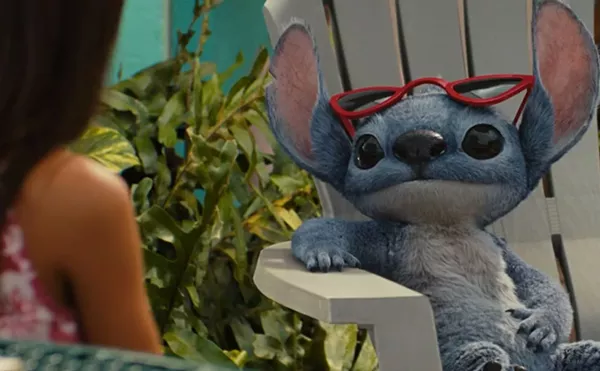
Audio By Carbonatix
[
{
"name": "GPT - Leaderboard - Inline - Content",
"component": "35519556",
"insertPoint": "5th",
"startingPoint": "3",
"requiredCountToDisplay": "3",
"maxInsertions": 100,
"adList": [
{
"adPreset": "LeaderboardInline"
}
]
}
]
It’s probably unfair to compare Tim Burton’s new film to his instant classic, The Nightmare before Christmas, but it can’t be helped. The director wears his fetishes on his sleeve, and his latest stop-action exercise in quirky misanthropy and macabre humor doesn’t have quite the same sparkle or wit as his cleverly creepy Christmastime confection from 1993.
To say Corpse Bride is classically “Burton-esque” is an understatement. The director’s infatuations with Victorian England, German expressionism and glib gothic horror are once again on full display. But it feels like we’ve seen it all before. There’s a knee-jerk quality to Burton’s obsessions, and at times Corpse seems to be cribbing from his earlier work.
Luckily, the film is filled with enough clever details and sly asides to keep things entertaining, and the art design is astonishing.
Victor Van Dort (Johnny Depp) is the skittish son of wealthy fishmongers (Paul Whitehouse and Tracey Ullman). In a bid to elevate their social status, Victor’s parents arrange for him to marry Victoria Everglot (Emily Watson), the shy daughter of bankrupt socialites. Much to everyone’s surprise, the betrothed discover they’re kindred spirits and become smitten with each other.
Still, Victor is a bundle of nerves, turning his wedding rehearsal into an unmitigated disaster. Embarrassed, he flees to the woods to practice saying his vows. When he jokingly places Victoria’s wedding band on a tree branch, he discovers that it’s actually the bony finger of a woman murdered in her wedding dress (Helena Bonham Carter). Now married to the corpse bride, Victor is whisked away to the land of the dead, a never-ending party town where hipster skeletons and sassy spirits cavort with graveyard glee.
In contrast, the world of the living is depicted as dreary and repressed, its unappealing citizens lacking the zest and vigor of the dead. Which prompts the question, why would Victor ever want to return home?
This leads us to The Corpse Bride’s biggest flaw — its protagonist. Victor is a weak leading character. Shy, bewildered and bland, he pales in comparison to the vibrant yearning and ghoulish naïveté of Nightmare’s Jack Skellington.
Burton would have been far wiser to focus the story on Emily, the dead bride. With decaying skin and ghostly beauty, she’s a poignant mix of sadness and horror, and Bonham Carter gives her just enough melancholy and plucky determination to win our affection. Teamed with a perversely hilarious sidekick — a Peter Lorre-inspired maggot who pops out of her eye socket to offer up Jiminy Cricket wisdom — Emily should be the center of our attention.
As expected, the art design and stop-action animation are nothing short of wondrous. Inspired by horror movies of the 1940s, the film’s attention to detail is magnificent, filled with demented shadows and wild camera angles. The characters, especially the dead, are gorgeously rendered, bursting with imagination and verve. Even in its dreariest moments, The Corpse Bride is a feast for the eyes.
Like Nightmare and Charlie and the Chocolate Factory, Danny Elfman wrote the movie’s half-dozen musical numbers. But except for a raucous, jazzy skeleton number, the songs are listless and instantly forgettable. The opening piece in particular is so lackluster, it threatens to derail the film before it even gets started.
There’s a sardonic moral to the morbid fable, a comment on the importance of promises and vows with regard to love and loyalty. Unfortunately, The Corpse Bride never achieves the proper emotional heft, and falls far short of the sweet-natured enchantment of Nightmare — a film it will forever be compared to.
Jeff Meyers writes about film for MetroTimes. Send comments to letters@metrotimes.com.





